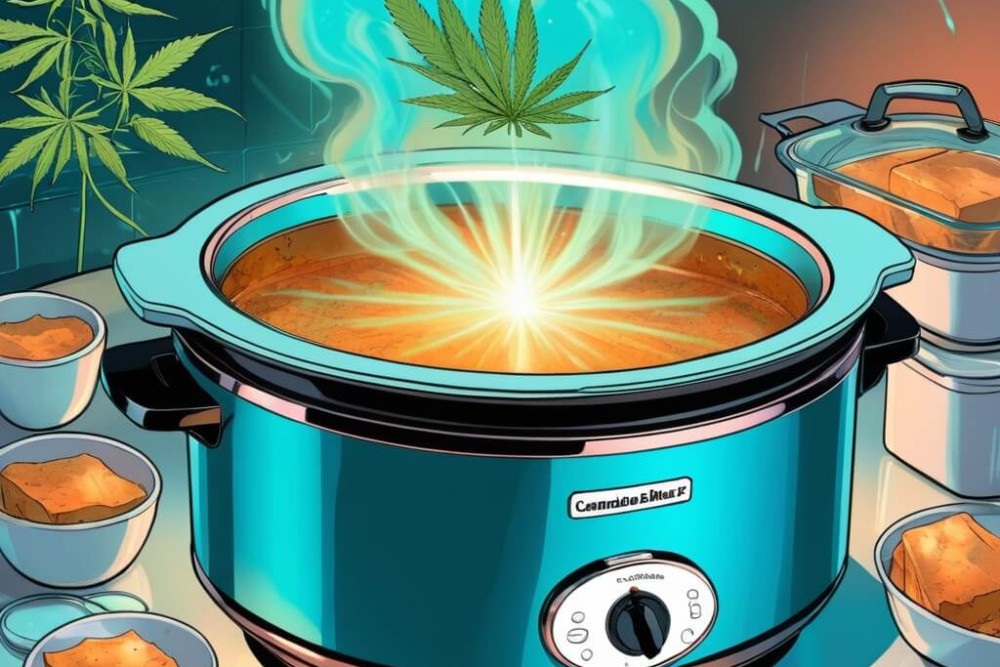
Slow and Low: Cooking cannabutter on a slow, low heat helps prevent burning and ensures thorough infusion.
Decarboxylation is Key: Heat your cannabis in the oven first to activate the THC.
Water is Your Friend: Adding water to the mix can help prevent scorching and makes for an easier separation of butter and plant material.
Straining Matters: Proper straining ensures a smooth, plant-free cannabutter.
Making cannabutter in a slow cooker is an excellent way to ensure a consistent, low heat that helps to infuse the butter thoroughly without the risk of burning it. This method is ideal for those who want to make a larger batch without having to monitor it constantly. Whether you're a seasoned chef or a beginner in the kitchen, this guide will walk you through the simple steps to make your own potent cannabutter using a slow cooker.
Cannabis: Roughly 1 ounce of decarboxylated cannabis.
Butter: 1 pound of unsalted butter. High-fat content is best for infusion.
Water: Enough to keep the butter from burning (about 2 cups).
Oven: For decarboxylating the cannabis.
Grinder: To grind the cannabis buds.
Slow Cooker: To cook the mixture on low heat.
Cheesecloth or Fine Mesh Strainer: For straining the finished product.
Storage Container: To store the cannabutter.
Before infusing your cannabis into butter, you must activate the THC through a process called decarboxylation:
Preheat your oven to 245°F (118°C).
Grind your cannabis coarsely and spread it evenly on a baking sheet lined with parchment paper.
Bake in the oven for about 30-40 minutes, stirring halfway through to ensure even decarboxylation.
Add the decarboxylated cannabis to the slow cooker.
Cut your butter into smaller pieces and add it to the slow cooker along with the water. The water helps regulate the temperature and prevent the butter from burning.
Set your slow cooker to low heat. Cover and let it cook for about 8 to 24 hours. The longer you allow the mixture to simmer, the more infused your butter will be. However, make sure not to overcook as it might lead to a more herbal flavor.
Stir occasionally to make sure the mixture isn’t burning on the bottom.
Once the cooking time is up, line a fine mesh strainer or a colander with cheesecloth and place it over your storage container.
Carefully pour the mixture through the cheesecloth, allowing the liquid butter to strain through. Avoid squeezing the cheesecloth too hard, as this can push more plant material into your butter.
Let the cannabutter cool at room temperature, then move it to the refrigerator to solidify. The water will separate from the butter and can be discarded after the butter hardens.
Once solid, remove the cannabutter from the water, dry it off, and store it in an airtight container.
Keep it refrigerated for short-term use or freeze for long-term storage.
The type of cannabis you choose will affect the potency and the type of high your cannabutter imparts. Indica strains generally result in a body high, while Sativa strains are more likely to produce a cerebral, energetic high.
Adjusting the ratio of cannabis to butter can increase or decrease the potency of your cannabutter. Feel free to experiment with different ratios depending on your personal preference and the desired strength.
While longer cooking times can increase the potency, they can also lead to a stronger, more pronounced cannabis flavor. Find a balance that suits your taste preferences.
Check out also: How To Press Rosin: A DIY Guide To Extracting Cannabis Concentrate!
Making cannabutter in a slow cooker is a foolproof method that yields consistent results. It's perfect for those who want to prepare cannabis-infused butter without much fuss or constant supervision. By following these simple steps and tips, you can create a versatile base for a variety of delicious, THC-infused recipes right in your own kitchen. Enjoy the process and the tasty treats that you can cook up with your homemade cannabutter!